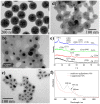One-step shell polymerization of inorganic nanoparticles and their applications in SERS/nonlinear optical imaging, drug delivery, and catalysis
- PMID: 24998932
- PMCID: PMC4083277
- DOI: 10.1038/srep05593
One-step shell polymerization of inorganic nanoparticles and their applications in SERS/nonlinear optical imaging, drug delivery, and catalysis
Abstract
Surface functionalized nanoparticles have found their applications in several fields including biophotonics, nanobiomedicine, biosensing, drug delivery, and catalysis. Quite often, the nanoparticle surfaces must be post-coated with organic or inorganic layers during the synthesis before use. This work reports a generally one-pot synthesis method for the preparation of various inorganic-organic core-shell nanostructures (Au@polymer, Ag@polymer, Cu@polymer, Fe3O4@polymer, and TiO2@polymer), which led to new optical, magnetic, and catalytic applications. This green synthesis involved reacting inorganic precursors and poly(styrene-alt-maleic acid). The polystyrene blocks separated from the external aqueous environment acting as a hydrophobic depot for aromatic drugs and thus illustrated the integration of functional nanoobjects for drug delivery. Among these nanocomposites, the Au@polymer nanoparticles with good biocompatibility exhibited shell-dependent signal enhancement in the surface plasmon resonance shift, nonlinear fluorescence, and surface-enhanced Raman scattering properties. These unique optical properties were used for dual-modality imaging on the delivery of the aromatic photosensitizer for photodynamic therapy to HeLa cells.
Figures







Similar articles
-
Core-shell polymeric nanoparticles co-loaded with photosensitizer and organic dye for photodynamic therapy guided by fluorescence imaging in near and short-wave infrared spectral regions.J Nanobiotechnology. 2020 Jan 23;18(1):19. doi: 10.1186/s12951-020-0572-1. J Nanobiotechnology. 2020. PMID: 31973717 Free PMC article.
-
Controllable synthesis and catalysis application of hierarchical PS/Au core-shell nanocomposites.J Colloid Interface Sci. 2012 Dec 1;387(1):47-55. doi: 10.1016/j.jcis.2012.07.093. Epub 2012 Aug 9. J Colloid Interface Sci. 2012. PMID: 22939252
-
Biocompatible Au@Ag nanorod@ZIF-8 core-shell nanoparticles for surface-enhanced Raman scattering imaging and drug delivery.Talanta. 2019 Aug 1;200:212-217. doi: 10.1016/j.talanta.2019.03.057. Epub 2019 Mar 14. Talanta. 2019. PMID: 31036175
-
Au@p4VP core@shell pH-sensitive nanocomposites suitable for drug entrapment.J Colloid Interface Sci. 2018 Mar 15;514:704-714. doi: 10.1016/j.jcis.2017.12.072. Epub 2017 Dec 31. J Colloid Interface Sci. 2018. PMID: 29310100 Review.
-
Design strategies, surface functionalization, and environmental remediation potentialities of polymer-functionalized nanocomposites.Chemosphere. 2022 Nov;306:135656. doi: 10.1016/j.chemosphere.2022.135656. Epub 2022 Jul 9. Chemosphere. 2022. PMID: 35820475 Review.
Cited by
-
Detection of Histamine Dihydrochloride at Low Concentrations Using Raman Spectroscopy Enhanced by Gold Nanostars Colloids.Nanomaterials (Basel). 2019 Feb 6;9(2):211. doi: 10.3390/nano9020211. Nanomaterials (Basel). 2019. PMID: 30736293 Free PMC article.
-
Methylene-Blue-Encapsulated Liposomes as Photodynamic Therapy Nano Agents for Breast Cancer Cells.Nanomaterials (Basel). 2018 Dec 23;9(1):14. doi: 10.3390/nano9010014. Nanomaterials (Basel). 2018. PMID: 30583581 Free PMC article.
-
A universal strategy for the fabrication of single-photon and multiphoton NIR nanoparticles by loading organic dyes into water-soluble polymer nanosponges.J Nanobiotechnology. 2022 Jul 6;20(1):311. doi: 10.1186/s12951-022-01515-5. J Nanobiotechnology. 2022. PMID: 35794602 Free PMC article.
-
Fabrication of an Au-doped Cu/Fe oxide-polymer core-shell nanoreactor with chemodynamic and photodynamic dual effects as potential cancer therapeutic agents.Sci Rep. 2022 Nov 4;12(1):18729. doi: 10.1038/s41598-022-23002-5. Sci Rep. 2022. PMID: 36333398 Free PMC article.
-
Hybrid Inorganic-Organic Core-Shell Nanodrug Systems in Targeted Photodynamic Therapy of Cancer.Pharmaceutics. 2021 Oct 23;13(11):1773. doi: 10.3390/pharmaceutics13111773. Pharmaceutics. 2021. PMID: 34834188 Free PMC article. Review.
References
Publication types
MeSH terms
Substances
LinkOut - more resources
Full Text Sources
Other Literature Sources
Miscellaneous

